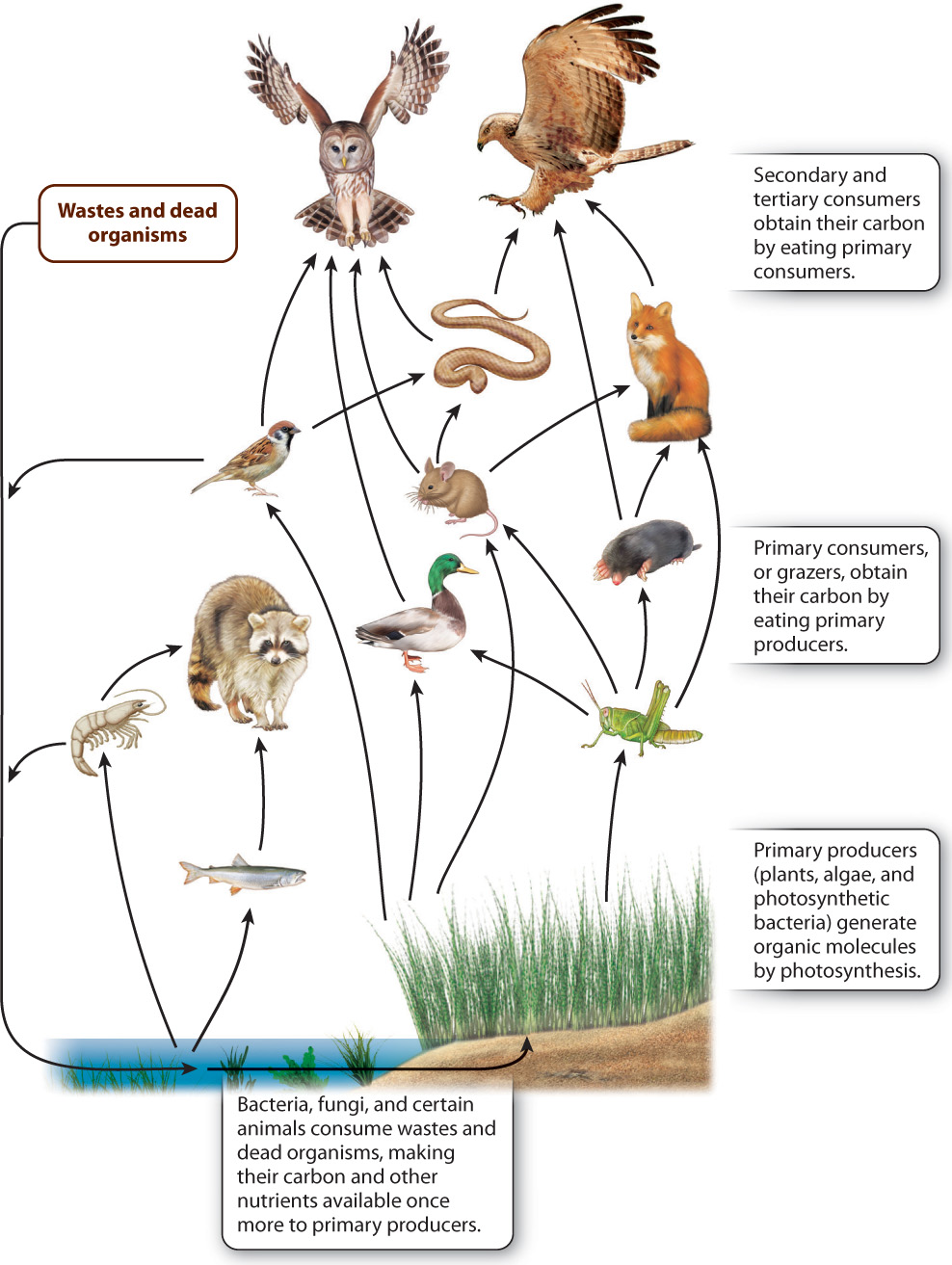CHAPTER SUMMARY
25.1 PHOTOSYNTHESIS AND RESPIRATION ARE THE KEY BIOCHEMICAL PATHWAYS FOR THE BIOLOGICAL, OR SHORT-TERM, CARBON CYCLE.
- Keeling began a program to monitor carbon dioxide levels in the atmosphere in 1958. Two patterns emerged: (1) carbon dioxide levels oscillate on a yearly basis, and (2) carbon dioxide levels have increased steadily to the present day since measurements began.
- The first pattern, seasonal oscillation, can be explained by the imbalance between photosynthesis and respiration in the summer and the winter months.
- The second pattern, of steady increase, can be extended further back in time by measuring the composition of air trapped in arctic gas bubbles. These measurements indicate that carbon dioxide levels in the atmosphere remained steady for more than a thousand years, but then started to increase in the mid-1800s, the time of the Industrial Revolution.
- The ratio of different isotopes of carbon in the atmosphere indicates that most of the carbon added to the atmosphere in recent decades comes from human activities, particularly the burning of fossil fuels.
25.2 PHYSICAL PROCESSES GOVERN THE LONG-TERM CARBON CYCLE.
- Physical processes, which act at slower rates and over longer time scales, are the major drivers of the long-term carbon cycle.
- In following carbon around its cycle, it is important to consider where carbon is stored (reservoirs) and rates at which it is added or removed from these stores (fluxes).
- Important reservoirs of carbon include organisms, the atmosphere, soils, the oceans, and sedimentary rocks. Sedimentary rocks are by far the largest carbon reservoir.
- Physical processes that remove CO2 from the atmosphere include the weathering of rocks, and those that add CO2 to the atmosphere include volcanoes and the oxidation of ancient organic matter in sedimentary rocks.
- The short-and long-term carbon cycles are linked by the slow leakage of organic matter from biological communities to sediments accumulating on the seafloor.
- Over the last 400,000 years, CO2 levels in the atmosphere have gone through periodic shifts that reflect repeated cycles of glaciation.
- CO2 levels in the atmosphere 500 million years ago may have been as much as 15 to 20 times higher than present-day levels. Over timespans of hundreds of millions of years, movements of Earth’s plates and the evolution of new life-forms are major players in the carbon cycle.
25.3 THE CARBON CYCLE CAN HELP US UNDERSTAND ECOLOGICAL INTERACTIONS AND THE EVOLUTION OF BIOLOGICAL DIVERSITY.
- Photosynthetic and other autotrophic organisms are primary producers, converting carbon dioxide into organic molecules.
- Heterotrophic organisms that eat primary producers are called primary consumers. Other heterotrophs that prey on these grazers are called secondary consumers.
- Interacting networks of species, linked by predator–prey interactions, are called food webs, and they are an important feature of the carbon cycle.
- Communities contain a much greater biomass of producers than consumers because the movement of energy through communities is inefficient.
- Photosynthetic organisms are well adapted to obtaining sunlight and nutrients in different environments.
- Respiring organisms are adapted to obtain different sources and sizes of food.
- The evolution of life on Earth can be considered a long history during which organisms have evolved different ways of obtaining energy and carbon from their environment.
- The interactions between biological and geologic processes at work in the carbon cycle have not only produced our current biological diversity. They are also responsible for Earth’s oxygen-rich atmosphere and oceans.
Self-Assessment Question 1
Name two processes that drive the short-term carbon cycle.
Show Model Answer
Model Answer:
Photosynthesis and respiration are key processes that drive the short-term carbon cycle.
Self-Assessment Question 2
Draw and explain the curve representing changing atmospheric levels of CO2 over the course of a year.
Show Model Answer
Model Answer:
The curve representing changing atmospheric levels of CO2 over the course of a year oscillates with the seasons because photosynthesis, which takes CO2 out of the atmosphere, is more active during the summer months and less active during the winter months. Respiration levels, which return CO2 to the atmosphere, remain constant throughout the year.
Self-Assessment Question 3
Draw and explain the curve representing changing atmospheric levels of CO2 over the past 150 years.
Show Model Answer
Model Answer:
The curve representing changing atmospheric levels of CO2 over the past 150 years shows a steady increase in levels of CO2, mainly due to human activities.
Self-Assessment Question 4
Explain one way by which the source of the increase in CO2 in the atmosphere can be determined.
Show Model Answer
Model Answer:
One way in which the source of increase in CO2 in the atmosphere can be determined is through the measurement and tracking of carbon isotopes. By measuring the ratios of all three carbon isotopes, scientists can hypothesize as to where the increase of CO2 is coming from.
Self-Assessment Question 5
Name processes that influence the long-term carbon cycle.
Show Model Answer
Model Answer:
The processes that influence the long-term carbon cycle are volcanism; chemical weathering; oceanic crust weathering; and oxidation of coal, oil, and ancient organic matter.
Self-Assessment Question 6
Draw and explain the curve representing changing atmospheric levels of CO2 over the last 400,000 years.
Show Model Answer
Model Answer:
The curve representing the changing atmospheric levels of CO2 over the past 500,000 years shows an oscillation pattern that seems to reflect the interglacial and glacial periods.
Self-Assessment Question 7
Trace the flow of carbon and energy through biological communities.
Show Model Answer
Model Answer:
See Figure 25.13 for an example of cycling carbon and energy through a community.
